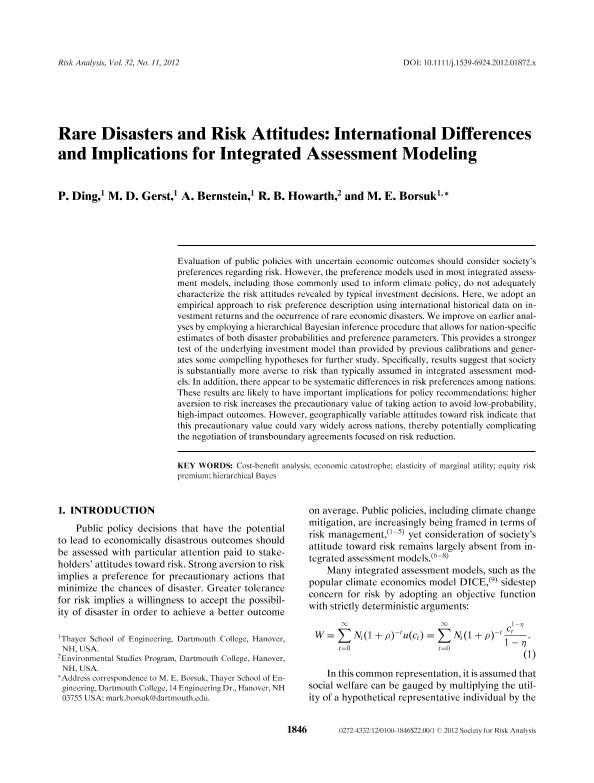Rare disasters and risk attitudes : international differences and implications for integrated assessment modeling

Contenido multimedia no disponible por derechos de autor o por acceso restringido. Contacte con la institución para más información.
| Tag | 1 | 2 | Value |
|---|---|---|---|
| LDR | 00000cab a2200000 4500 | ||
| 001 | MAP20130001975 | ||
| 003 | MAP | ||
| 005 | 20130417120847.0 | ||
| 008 | 130125e20121105esp|||p |0|||b|spa d | ||
| 040 | $aMAP$bspa$dMAP | ||
| 084 | $a7 | ||
| 245 | 0 | 0 | $aRare disasters and risk attitudes$b: international differences and implications for integrated assessment modeling$cP. Ding...[et.al] |
| 520 | $aEvaluation of public policies with uncertain economic outcomes should consider society's preferences regarding risk. However, the preference models used in most integrated assessment models, including those commonly used to inform climate policy, do not adequately characterize the risk attitudes revealed by typical investment decisions. Here, we adopt an empirical approach to risk preference description using international historical data on investment returns and the occurrence of rare economic disasters. We improve on earlier analyses by employing a hierarchical Bayesian inference procedure that allows for nation-specific estimates of both disaster probabilities and preference parameters. This provides a stronger test of the underlying investment model than provided by previous calibrations and generates some compelling hypotheses for further study. Specifically, results suggest that society is substantially more averse to risk than typically assumed in integrated assessment models. In addition, there appear to be systematic differences in risk preferences among nations. These results are likely to have important implications for policy recommendations: higher aversion to risk increases the precautionary value of taking action to avoid low-probability, high-impact outcomes. However, geographically variable attitudes toward risk indicate that this precautionary value could vary widely across nations, thereby potentially complicating the negotiation of transboundary agreements focused on risk reduction. | ||
| 650 | 1 | $0MAPA20080602635$aModelos de evaluación | |
| 650 | 1 | $0MAPA20080602437$aMatemática del seguro | |
| 650 | 1 | $0MAPA20080591953$aMétodos actuariales | |
| 650 | 1 | $0MAPA20080592059$aModelos predictivos | |
| 650 | 1 | $0MAPA20080545260$aRiesgos | |
| 650 | 1 | $0MAPA20080550424$aDesastres | |
| 700 | 1 | $0MAPA20130004907$aDing, P. | |
| 773 | 0 | $wMAP20077000345$tRisk analysis : an international journal$dMcLean, Virginia : Society for Risk Analysis, 1987-2015$x0272-4332$g05/11/2012 Volumen 32 Número 11 - noviembre 2012 , p. 1846-1855 |

